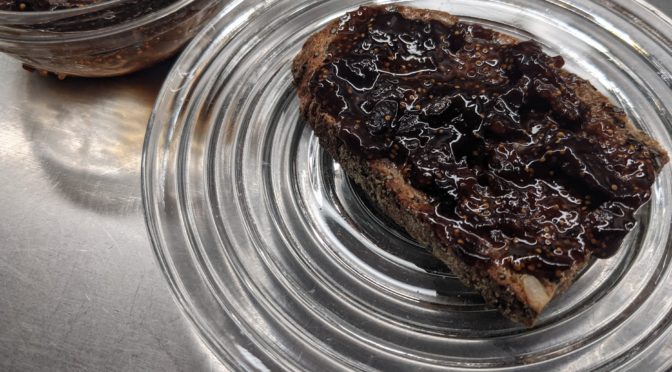24 ounces dried black (Mission) figs
6 black (decaf) tea bags
2 cups sugar
a package of powdered pectin
¼ cup bottled lemon juice
In a 6 quart pot on a high heat, bring
- 4 cups of water
to a boil, turn off the heat, add
- 8 black tea bags
- 24 ounces dried figs
Make sure the tea bags and figs are all submerged and cover the pot. Wait 30 minutes to an hour so the fruit will be fully hydrated. Fish the fruit and tea bags out of the liquid, leaving the liquid in the pot. Discard the tea bags. Trim the stems from the figs and then chop the fruit as you like. I prefer a rough chop, but you can go for as fine or coarse as you like.
Return the fruit to the pot, adding
- ¼ cup bottled lemon juice (see safety note below)
and bring to a boil over high heat, cook 10 minutes on a hard boil. Stir regularly to make sure the mixture doesn’t scorch. You may want to mash the the fruit with a potato masher if it looks too coarse. An immersion blender might work, but I really wouldn’t want to have the fruit pureed, so I just used the masher a bit. Meanwhile, in 1 quart bowl, combine
- 2 cups sugar
- 3 TBL pectin (pectin powder, not pectin-sugar)
Dump this mixture into the pan, stir to dissolve and return to a hard boil, stirring and let it cook for 5 minutes. Turn off the heat.
I processed half-pint jars in a boiling water bath for 15 minutes but I encourage you to freeze the jam in suitable containers. Read the next paragraph…
Safety note: the USDA recommends using bottled lemon juice as it has calibrated minimum acidity levels, ensuring that the food is sufficiently acidic to avoid the possibility of spoilage. I adapted this recipe from another recipe, cited below, reducing the lemon juice, so I can’t vouch for the safety of canning this jam. In addition, I used fresh lemon juice, which the USDA would discourage you from using. To be safe, you should probably freeze the jam and keep it refrigerated when you defrost a container rather than canning the jam.

